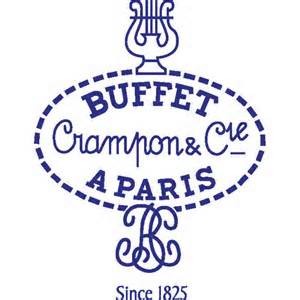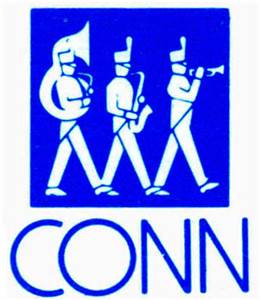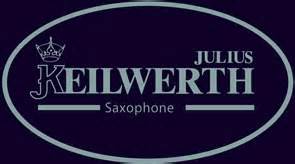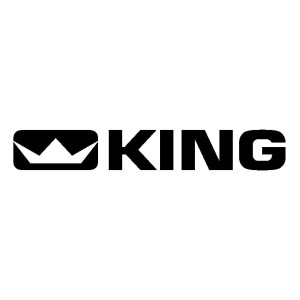|
H. Couf
From 1965 until 1988, these fine German horns (manufactured by J. Keilworth) were distributed at various times by W. T. Armstrong and Conn. They have quite a cult following today, and with good reason. The Superba I has rolled tone holes, the Superba II does not. I’ve never seen them in anything but lacquer.
SUPERBA I Alto $ 2200
Tenor $ 2800
Baritone $3300
SUPERBA II Alto
$1800 Tenor $2200
Baritone $3000
Before the current model lineup evolved, Keilworth imported some nice horns stamped “The New King” with rolled tone holes and plastic key guards (must be intact) that have a small following. Mostly in lacquer, add 10% for silver.
Alto $1000
Tenor $1200
Except for the Saxello, I can’t find anybody expressing much interest in the Kings made before the Zephyr. I find their intonation to be sketchy at best. The engraving is beautiful, but they just don’t play very well. The Zephyr is a killer! The Zephyr Special had a solid silver neck and mother of pearl key touches. I understand there were a few made with sterling silver bells. After the mid 1950’s, the Zephyr became an intermediate model, so deduct 30%. The Zephyr baritone remained essentially unchanged throughout the production run and sound great. Most of the Zephyr series was in lacquer, add 15% for silver. 20% for gold. Around number 272XXX, the Super 20 was introduced. The first examples had mother of pearl key touches; sunburst engraving on the bell keys; socket necks; and optional sterling silver necks (add 15%) and sterling silver bells (add 30%). Around 430XXX, the Super 20 was cheapened considerably: the neck changed to a conventional style; the bell key engraving eventually went away; the mother of pearl inlay was long since gone. Deduct 25% for horns after this number. There are a few examples with gold inlay on the silver bell (add 15%), a few rare silver plated horns (I own one, add 20%); and a very few gold plated ones (add 25%). There are, of course, a very few Super 20 baritones, some with silver necks (add 15%) and I have seen one with a silver bell. I think the Kings have strong upside appreciation potential.
Saxello soprano $ 3200 add 15% for gold plate
Alto Zephyr $1800
Alto Zephyr Spcl. $2400 add 15% for silver neck
Alto Super 20 $2600 see above commentary for adjustments
Tenor Zephyr $ 2400
Tenor Zephyr Spcl $ 3000 add 15% for silver neck
Tenor Super 20 $ 3400 see above commentary for adjustments
Baritone Zephyr $ 2900
Baritone Super 20 $ 4000
MARTIN
These horns are under appreciated . They are undervalued. Play one in good adjustment and you’ll see what I mean. I’ve used a The Martin baritone for years. They are the best of the vintage baritones. All of the Martin horns have a sweet sound, and a very lush lower end. The horns from 1933 (Handcraft Committee) through the early 60’s (the Magna) can hold their own with anything ever made. There are lots of variations on the Martin theme, and below are the ones that I think you should consider. The early ones are mostly seen in silver, add 15% for gold plate. From the Committee on, they are almost always lacquer. Add 15% for silver, 25% for gold. .I’ve seen a couple of Committee models with sterling silver necks. Add $15% for this feature.
MARTIN HORNS THROUGH 1933
Soprano straight $1000
Soprano curved $1800
Alto $ 800
Alto “Typewriter” $ 1200
C soprano $1000
C melody $ 800
Tenor $ 800
Tenor “Typewriter” $ 1400
Baritone $ 2200
Baritone “Typewriter” $ 3500
Bass $ 7000
COMMITTEE AND COMMITTEE II THROUGH 1945 Alto $ 1800
Tenor $ 2900
Baritone $ 3100
Alto $ 2000
Alto Magna $ 2300
Tenor $ 3600
Tenor Music Man $2800 very rare, but fabulous!
Tenor Magna $ 3900
Baritone $ 3400 has no chromatic F#
Baritone Magna $ 3600
The name alone inspires reverence. It’s generally agreed that Selmer made some of the very best horns of all time. Some models certainly command the highest prices. Selmer has the only legitimate claim to be the direct successor of Adolphe Sax. I believe that the models before the Balanced Action are overpriced. You can buy two wonderful old Conns for what some people are asking for Selmers of the same era. I have found that most of the action in pre-Balanced Action horns is just talk. There seem to be very few people (outside of a few collectors) buying these horns.
MODELE 22 750 – 4450 The earliest examples are stamped Serie 22. and have a unique side Bb mechanism. Add 20% for these. Add 15% for silver, 25% for gold plate.
Soprano $1500
Alto $1200
Tenor $1400
Baritone $1800
MODELE 26 4451 – 11950 Basically the same horn as the 22. Similar adjustments for finish.
Soprano $1500
Alto $ 1200
Tenor $1400
Baritone $1800
SUPER 11951 – 18700 These come in three flavors: New Largebore (11951 –13000); Cigar Cutter (13,000 – 17,000), and Super (17,000 – 18,700). These are the first horns that really sound like Selmers. The differences in the variations are pretty minor, mostly in mechanism. Much better horns than the 22’s and 26’s. Some of these are beautifully engraved (add 10%). Silver is not uncommon (add 15%), gold a little more scarce (add 20%)..
Soprano $1500
Alto $ 1800
Tenor $ 2000
Baritone $ 2800
RADIO IMPROVED 18701 – 21750 This is essentially a renamed Super with different engraving. I’ve seen a couple of people pay some really stupid prices for these. They do play rather nicely, and you sometimes see them in silver (add 20%) and I’ve heard there were some gold ones.
Alto $ 2900
Tenor $ 3400
BALANCED ACTION 21751 – 35800 There is a very good reason that demand (and prices) for these horns is so high: although not without their quirks, these are wonderful instruments. The later examples have better intonation in the upper end than the earlier examples. They are often beautifully engraved. Silver examples bring about a 20% premium; gold plate about 30% more.
Alto $ 3400
Tenor $ 5000
Baritone $ 4500
SUPER BALANCED ACTION 35801- 53200 Almost perfection ! Better feel and intonation than the Balanced.. The engraving is usually not too elaborate.
Alto $4600
Tenor $5500
Baritone $6500 There are a few low A baritones. I have a customer who owns one
MARK VI 53201 – 236000 Of course, this is The Big Daddy Rabbit With the Fuzzy Tongue. Nothing else is quite like it. Longest production run in Selmer history. Lots of minor variations along the line: necks; engraving; side key attachment etc., but even the worst of them is not bad. I’ve always thought that horns without the optional high F# key played a little better. There seems to be more demand for the “five digit” horns, and some snobs reject the higher numbered examples. More than with any other model, condition is everything. Silver plate commands a 20% premium; gold a 30% premium. It’s important that the serial numbers on the neck match the body. Sopranino, soprano, baritone, and bass Mk VI’s were made until the introduction of the Super 80 series. Horns made for the European market are often unengraved, and lacquered examples may have silver plated keywork.
Sopranino $3000
Soprano $3000
Alto $ 6100
Alto Low A $ 5000
Tenor $ 7000
Baritone Bb $7000
Baritone low A $7200
MARK VII 236000 – 315000 The Mark VI was an impossible act to follow. The VII was rejected by the Selmer faithful. I think the ones below around 275000 are good horns, and that you should be careful above that number. Silver plated ones bring 20% more, I’ve never seen a gold plated one. Engraving is uncommon above 275000. These horns can be a real bargain when you find a good one!
Alto $2400
Tenor $2900
SML
This small company made around 25000 horns between 1937 and 1982 and have a fanatical following. I’m one of those fanatics. They’re great! There are many variations, but later examples tend to have rolled tone holes, adjusting screws for the stack keys, beautiful engraving, and a sound that’s hard to beat. You see them in lacquer, silver (add 15%), gold (add 20%) and I’ve seen one nickel plated alto.
Soprano $ 2200
Alto $ 2800
Tenor $ 3600






